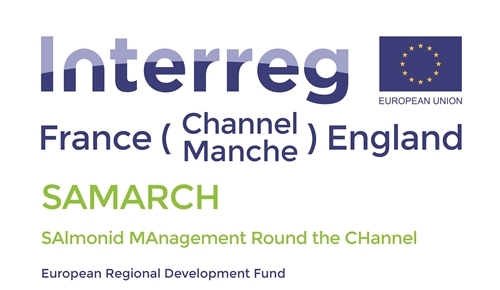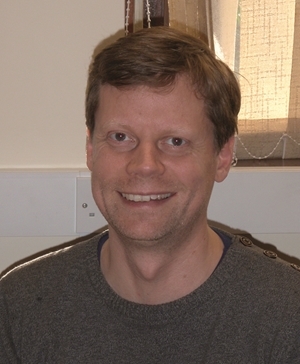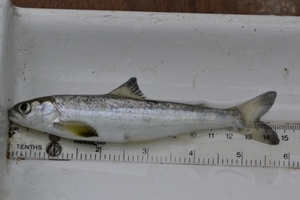
A WORRYING decline in numbers of young salmon has been announced by the fisheries team at the Game & Wildlife Conservation Trust (GWCT), who have been working with Cefas and the Environment Agency 1.
Their records show that the number of juvenile salmon leaving the River Frome in Dorset for their feeding grounds in the North Atlantic in 2017 are likely to result in a marked reduction in the numbers of adult salmon returning to our rivers in the next few years. This work forms part of a project called SAMARCH, which is part funded by the EU’s Interreg Channel Programme 2.
The numbers of smolts leaving the River Frome in the spring of 2017, (4,381 ±670) was the worst on record and less than half of the 10-year average (9,689) and 2,000 fewer than the second worst year on record.
 Dr Rasmus Lauridsen, Head of Fisheries Research for GWCT, said: “The number of young salmon leaving our rivers has a direct effect on the number of adults returning to spawn. With adult numbers already at an all-time low, this is worrying data for an iconic and economically important species.”
Dr Rasmus Lauridsen, Head of Fisheries Research for GWCT, said: “The number of young salmon leaving our rivers has a direct effect on the number of adults returning to spawn. With adult numbers already at an all-time low, this is worrying data for an iconic and economically important species.”
Juvenile salmon - also known as “parr” - grow fast in southern English chalk streams and >95% smoltify and leave the River Frome when they are one year old.
On rivers in the rest of the UK, most salmon smolt leave for the sea at two to three years old. The poor 2017 smolt run on River Frome was, therefore, a result of recruitment from the adult fish that spawned in the winter of 2015/16. Low numbers of young salmon were already apparent during the GWCT’s annual parr tagging campaign in late summer of 2016, for which the catchment population was estimated to be 35,151 - substantially fewer than the 10-year average (91,353).
Poor recruitment of salmon from the 2015/16 spawning season has been observed in many rivers across England and Wales, suggesting it’s a national, rather than a local, phenomenon.
In 2015, GWCT recorded 822 adults entering the River Frome for the 2015/16 spawning season, which was slightly more than the 10-year average 746. This suggests that the problem affecting recruitment must have occurred sometime between spawning in the winter of 2015/2016 and the late summer of 2016 rather than fewer than normal spawning fish.
During the early part of the winter in 2015/16, when the adult salmon were laying their eggs, unseasonal warm weather prevailed.
The high air temperature was reflected in high River Frome water temperatures: the average water temperature for December 2015 was 11.2°C, which is the warmest December temperature recorded this millennium, 3.3°C warmer than the average December temperature and 2.0°C warmer than the second warmest in this millennium.
GWCT speculates that the high water temperature during spawning and early egg incubation had a negative impact on egg survival and subsequent parr recruitment.
As a result of the low numbers of smolts in 2017, it is expected that fewer adults to return to River Frome in 2018 and 2019, namely salmon that spent 1 and 2 years at sea, respectively.
 Furthermore, the Trust would expect fewer than average adult returns in other affected rivers throughout the UK, albeit that the effects might be seen in later years depending on the age that their smolts go to sea.
Furthermore, the Trust would expect fewer than average adult returns in other affected rivers throughout the UK, albeit that the effects might be seen in later years depending on the age that their smolts go to sea.
Dr Lauridsen added: “This is a stark reminder of the importance of the freshwater stage of the salmon lifecycle and it’s potential to affect stocks in subsequent years.”
Notes to Editors
1 For the past 16 years, the Game & Wildlife Conservation Trust, in collaboration with Cefas, has quantified the number of juvenile Atlantic salmon emigrating from the River Frome (Dorset, UK) to sea (also known as the “smolt run”). We report this information to the International Council for the Exploration of the Seas (ICES) who oversee setting of conservation targets and fishing quotas for salmon populations around the Atlantic basin.
2 The SAlmonid MAnagement Round the CHannel project called SAMARCH is part funded by the EU Interreg Channel Programme. It aims to improve our knowledge and understanding of salmon and sea trout population in our coastal waters to ultimately improve the way they are managed and increase stocks. https://interreg5a-fce.eu/en/news-and-events/news/protecting-our-wildlife-project-samarch-to-improve-management-of-salmon-and-sea-trout-populations-in-the-english-channel/
Project Partners:
· Lead Partner: Game & Wildlife Conservation Trust (UK)
· Institut National de Recherche Agronomique (France)
· Institut National Supérieur des Sciences Agronomiques, Agroalimentaires, Horticoles et du Paysage (France)
· University of Exeter (UK)
· Bournemouth University (UK)
· Environment Agency (UK)
· Salmon and Trout Conservation (UK)
· Aence Française pour la Biodiversité (France)
· Normandie Grands Migrateurs (France)
· Bretagne Grands Migrateurs (France)
The Interreg FCE Programme is a European Territorial Cooperation programme that aims to fund high quality cooperation projects in the Channel border region between France and England. It focuses on a range of specific objectives including supporting innovation, improving the attractiveness of the FCE area and developing low carbon technologies. The Programme has a total of €223 million of ERDF funds to distribute by 2023 and is managed by Managing Authority Norfolk County Council.
The Programme operates within a clearly defined eligible area, covering the South and East Coasts of England from Cornwall to Norfolk, and the North Coast of France from Finistère to Pas-de-Calais. The programme area can be found here.
More information about the Programme can be found at https://interreg5a-fce.eu/.